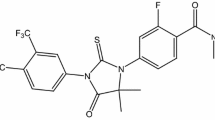Summary
SK&F L-94901 is a novel thyromimetic, structurally related to thyroxine. The absorption, distribution, excretion and metabolism of radiochemically labelled [14C]-SK&F L-94901 has been investigated in the rat, dog and cynomolgus monkey. Oral absorption from solution was l ow or moderate in all three species. The compound was widely distributed and rapidly excreted, although traces of radioactivity were still evident in some tissues at 7 days post-dose, particularly in the kidney where radioactivity was located in an area approximating to the corticomedullary junction. Elimination of [14C]-SK&F L-94901 was both metabolic, mediated by the liver, and renal. The major metabolic routes of elimination were via oxidative deamination to lactate and acetate derivatives.
Similar content being viewed by others
Abbreviations
- m:
-
multiplet
- q:
-
quartet
- t:
-
triplet
- d:
-
doublet
- s:
-
singlet
References
Underwood A.H., Emmett J.C., Ellis D., et al. (1986): A thyrornimetic that decreases plasma cholestérol levels without increasing cardiac activity. Nature, 324, 425–429.
Crowe A.M., Lawrie K.W.M., Saunders D. (1988): Synthesis of [14C]-SK&F L-94901, a novel thyrornimetic. J. Labelled Comp. Radiopharm., 25, 763–772
Hickey D.M.B., Leeson P.D., Novelli R., et al. (1988): Synthesis of thyroid hormone analogues. Part HI. Iodonium salt approaches to SK&F L-94901. J. Chem. Soc. Perkin Trans., 1, 3103
Chipman J.X., Cropper N.C. (1977): A technique for chronic intermittent bile collection from the rat. Res. Vet. Sci., 22, 366–370.
Strom S.C., Jirtle R.L., Jones R-S., et al. (1982): Isolation, culture and transplantation of human hepatocytes. J. Natl. Cancer Inst., 68, 771–778.
Flock E.V., David C., Stobie G.H.C., Owen C.A. (1963): 3,3′5′-Triiodorayronine and 3,3′-diiodothvroiiine: Partially deiodinated intermediates in the metabolism of thyroid hormones. Endocrinology, 73, 442–455.
Takai N.A., Rapoport B., Yamamoto M. (1980): Biliary excretion of iodo thyronines in rats as determined by high pressure liquid chromatography: Effect of starvation. Endocrinology, 107, 176–182.
Kennedy S., Atterwffl C., Poole A. (1988): Pathology of SK&F L-94901, a potent thyrornimetic in the rat. The Toxicologist, Abstracts of 27th Annual Meeting, 8, Abstract No. 348.
Franklin E.R., Chasseaud L.F., Taylor T. (1977): The distribution of radioactivity in pregnant rats after repeated oral doses of the diuretic agent Etozolin. Arzneimittelforsch., 27, 1800.
Benard P., Braun J.P., Rico A.G. (1986): Whole-body autoradiography as a tool for prediction of nephrotoxicity of xenobiotics. Proc. R. Microscopical Soc., 21, 277.
Faber J. (1984): The metabolism of iodothyronines in health and disease with special reference to diiodothyronines. Danish Med. Bull., 31, 257–270.
Van Middlesworth L. (1974): Metabolism and excretion of thyroid hormones. In: Green M.A., Solomon D.H. eds. Handbook of Physiology, Section 7: Endocrinology, vol. Ill: Thyroid. Washington, Am. Physiol. Soc., pp. 215–231.
Fletcher K. (1957): The fractionation of urinary iodine 2. Metabolites excreted during treatment of carcinoma of the thyroid. Biochem. J., 67, 140–146
Tomita K., Lardy H.A., Larson F.C., Albright E.C. (1956): Enzymatic conversion of thyroxine to tetraacetic acid and of triiodothyronine to triiodothyroacetic acid. J. Biol. Chem., 244, 387–397
Etling N., Barker S.B. (1959): Metabolism of thyroxine during prolonged kidney cortex incubations. Endocrinology, 64, 753–765.
Nakamura Y., Chopra I.J., Solomon D.H. (1978): An assessment of the concentration of acetic acid and propionic acid derivatives of 3,5,3′-triiodothyronine in human serum. J. Clin. Endocrinol. Metab., 46, 91–97.
Gavin L.A., Livermore B.M., Cavalieri R.R., Hammond M.E., Castle J.N. (1980): Serum concentration, metabolic clearance, and production rates of 3,5,3′-triiodoacetic acid in normal and athyreotic man. J. Clin. Endocrinol. Metab., 51, 529–534.
Pittman C.S., Shimizu T., Burger A., Chambers J.R. (1980): The nondeiodinative pathways of thyroxine metabolism: 3,5,3′5′-tetraiodoacetic acid turnover in normal and fasting human subjects. J. Clin. Endocrinol. Metab., 50, 712–716.
Author information
Authors and Affiliations
Rights and permissions
About this article
Cite this article
Pue, M.A., Ransley, J.A., Writer, D.J. et al. The disposition of SK&F L-94901, a selective thyromimetic in rat, dog and cynomolgus monkey. European Journal of Drug Metabolism and Pharmacokinetics 14, 209–219 (1989). https://doi.org/10.1007/BF03190101
Received:
Issue Date:
DOI: https://doi.org/10.1007/BF03190101




